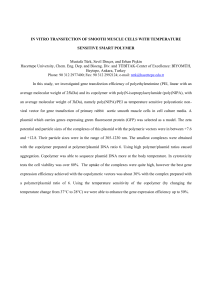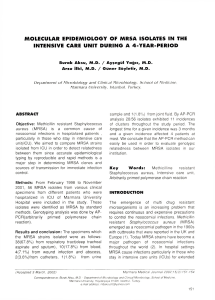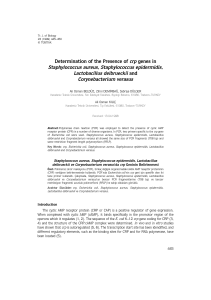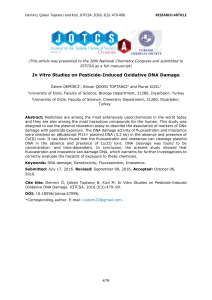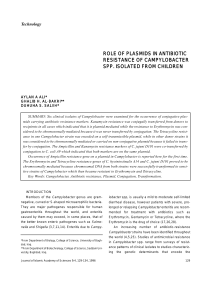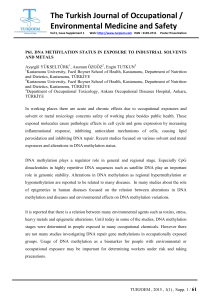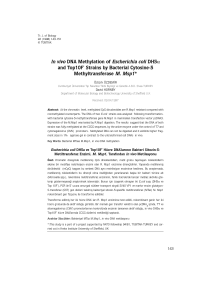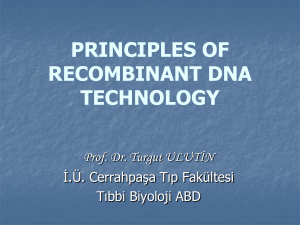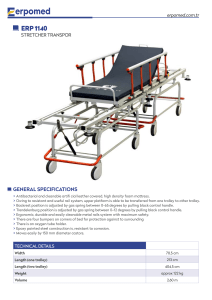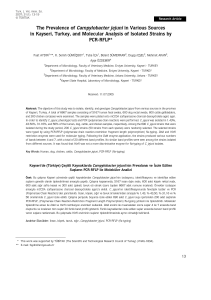antibiotic susceptibility and r-plasmid mediated drug
advertisement
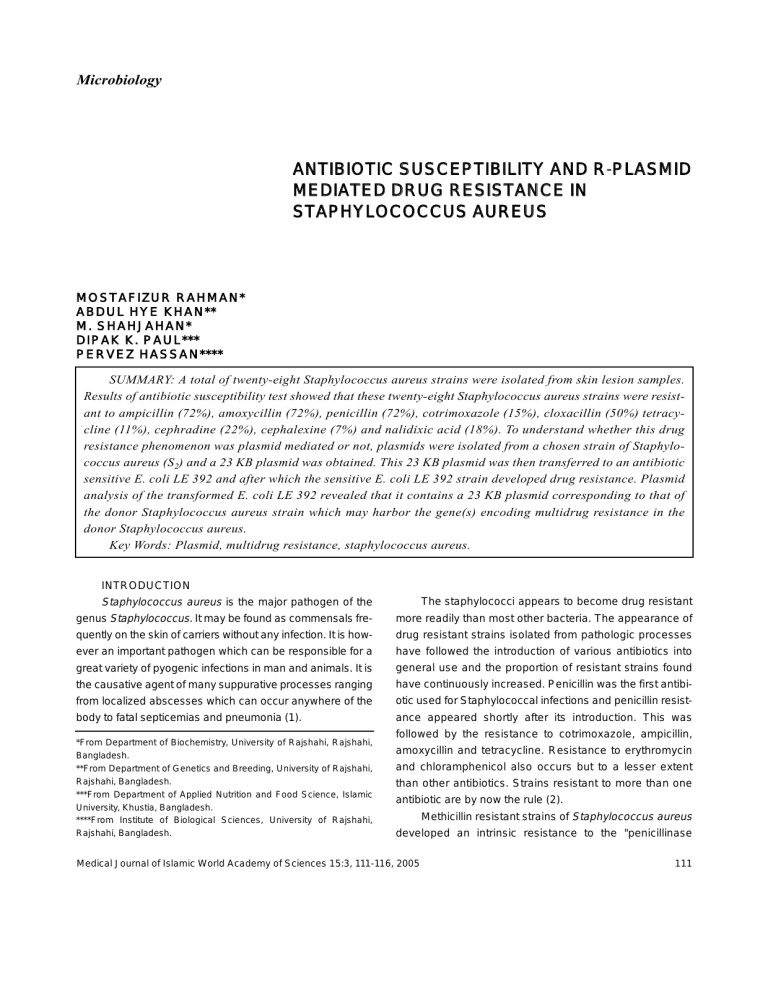
Microbiology ANTIBIOTIC SUSCEPTIBILITY AND R-P PLASMID MEDIATED DRUG RESISTANCE IN STAPHYLOCOCCUS AUREUS MOSTAFIZUR RAHMAN* ABDUL HYE KHAN** M. SHAHJAHAN* DIPAK K. PAUL*** PERVEZ HASSAN**** SUMMARY: A total of twenty-eight Staphylococcus aureus strains were isolated from skin lesion samples. Results of antibiotic susceptibility test showed that these twenty-eight Staphylococcus aureus strains were resistant to ampicillin (72%), amoxycillin (72%), penicillin (72%), cotrimoxazole (15%), cloxacillin (50%) tetracycline (11%), cephradine (22%), cephalexine (7%) and nalidixic acid (18%). To understand whether this drug resistance phenomenon was plasmid mediated or not, plasmids were isolated from a chosen strain of Staphylococcus aureus (S2) and a 23 KB plasmid was obtained. This 23 KB plasmid was then transferred to an antibiotic sensitive E. coli LE 392 and after which the sensitive E. coli LE 392 strain developed drug resistance. Plasmid analysis of the transformed E. coli LE 392 revealed that it contains a 23 KB plasmid corresponding to that of the donor Staphylococcus aureus strain which may harbor the gene(s) encoding multidrug resistance in the donor Staphylococcus aureus. Key Words: Plasmid, multidrug resistance, staphylococcus aureus. INTRODUCTION Staphylococcus aureus is the major pathogen of the The staphylococci appears to become drug resistant genus Staphylococcus. It may be found as commensals fre- more readily than most other bacteria. The appearance of quently on the skin of carriers without any infection. It is how- drug resistant strains isolated from pathologic processes ever an important pathogen which can be responsible for a have followed the introduction of various antibiotics into great variety of pyogenic infections in man and animals. It is general use and the proportion of resistant strains found the causative agent of many suppurative processes ranging have continuously increased. Penicillin was the first antibi- from localized abscesses which can occur anywhere of the otic used for Staphylococcal infections and penicillin resist- body to fatal septicemias and pneumonia (1). ance appeared shortly after its introduction. This was *From Department of Biochemistry, University of Rajshahi, Rajshahi, Bangladesh. **From Department of Genetics and Breeding, University of Rajshahi, Rajshahi, Bangladesh. ***From Department of Applied Nutrition and Food Science, Islamic University, Khustia, Bangladesh. ****From Institute of Biological Sciences, University of Rajshahi, Rajshahi, Bangladesh. followed by the resistance to cotrimoxazole, ampicillin, amoxycillin and tetracycline. Resistance to erythromycin and chloramphenicol also occurs but to a lesser extent than other antibiotics. Strains resistant to more than one antibiotic are by now the rule (2). Methicillin resistant strains of Staphylococcus aureus developed an intrinsic resistance to the "penicillinase Medical Journal of Islamic World Academy of Sciences 15:3, 111-116, 2005 111 ANTIBIOTIC SUSCEPTIBILITY AND PLASMID MEDIATED DRUG RESISTANCE stable penicillin" like cloxacillin etc (3). This resistance to methicillin is often accompanied by resistance to many other antibiotics (4). In Bangladesh reports of strains resistant to cotrimoxazole, cephradine, erythromycin, gentamicin, ampicillin, chloramphenicol and nitrofurantoin was documented in a recent investigation (5). Plasmid mediated drug resistance in Staphylococcus aureus was reported by many workers. Reports about plasmid mediated resistance to chloramphenicol, gentamycin, tobramycin and kanamycin in Staphylococcus aureus were also documented (6). Similarly Staphylococcus aureus strains possessed plasmid copies of β-lactamase determinant was also documented (7). Moreover, besides plasmid mediated drug resistance, chromosomal DNA mediated multiple drug resistance phenomenon in Staphylococcus aureus was also reported by many workers (8-9). In our study we have tried to evaluate antibiotic susceptibility of Staphylococcus aureus isolated from skin lesions samples collected from skin of out patients of Rajshahi Medical College Hospital and Medical Center of Rajshahi University. We have tried to establish the antibiotic susceptibility profile of Staphylococcus aureus. Here we report on the isolation of a single 23 KB plasmid from a selected multidrug resistant strain of Staphylococcus aureus. We have also tried to present evidences that this 23 KB plasmid of multidrug resistant Staphylococcus aureus might harbor the gene(s) that endow multiple drug resistance in the selected Staphylococcus aureus and to find out the connection between the presence of plasmid and acquisition of drug resistance phenomenon in Staphylococcus aureus. RAHMAN, KHAN, SHAHJAHAN, PAUL, HASSAN tubes. In some instances blood, sputum and spinal fluid was collected depending upon the localization of infection processes. Samples were inoculated on to blood agar and nutrient agar plates. Well isolated colonies were picked up and stored in nutrient agar slant. Pure culture of the isolates were done by isolating single colonies from the stored bacteria. E. coli LE 392 used in the transformation experiment was supplied by the Department of Biochemistry and Molecular Biology, Yamaguchi University, Japan. Screening and identification of bacteria All forty bacterial samples were subjected to hemolysis test on blood agar and β-hemolytic bacteria were isolated and purified. β-Hemolytic strains were further screened through Gram staining and catalase tests. All the primary screened strains were subjected to various morphological and biochemical tests (10). In vitro antibiotic susceptibility test of Staphylococcus aureus All the finally identified Staphylococcus aureus strains were subjected to in vitro antibiotic susceptibility test by antibiotic disc diffusion method (11). Ten commonly used antibiotics were used in the test. Extraction, purification and estimation of plasmid DNA A multiple drug resistant strain of Staphylococcus aureus was selected for plasmid extraction. Plasmid DNA was extracted from 100 ml over night broth culture of the selected multiple drugs resistant Staphylococcus aureus strain by a standard method (12). The plasmid DNA was purified with polyethylene glycol (PEG-8000) and estimated by spectrophotometric method (13). Electrophoretic analysis of the plasmid DNA Agarose gel electrophoresis of plasmid DNA of a selected multidrug resistant strain of Staphylococcus aureus was carried out on 0.8% agarose (14). Plasmid DNA transfer to sensitive E. coli LE 392 As an attempt to transfer plasmid DNA to sensitive E.coli LE 392 competent cells were prepared by calcium chloride procedure and then transformation experiment was carried out (15). MATERIALS AND METHODS Media and culture condition Nutrient agar was used as general media. Blood agar, Gelatin agar, Muller-Hinton agar, Kligler's iron agar, Mannitol agar, Christensen's urea agar and DNAase agar were used in the isolation and identification. Bacterial culture was done at 37ºC through out the experiment. Collection of bacterial samples About forty bacterial samples were collected from out door of Dermatology Department, Rajshahi Medical College Hospital and Pathological Laboratory of Rajshahi University Medical Center. Samples were collected from pus of wounds, abscesses and other skin lesions using sterile cotton swabs in sterile test 112 Study of plasmid profile of the transformed E. coli LE 392 Transformed E. coli LE 392 was subjected to plasmid DNA extraction (12). The extracted plasmid DNA was purified with polyethylene glycol (PEG-8000) and subjected to agarose gel electrophoresis on 0.8% agarose (14). RESULTS Screening and identification of Staphylococcus aureus strain All the forty bacterial strains were initially subjected to hemolysis test on blood agar, Gram staining and catalase test in an attempt to screen the β-hemolytic, Gram positive Medical Journal of Islamic World Academy of Sciences 15:3, 111-116, 2005 ANTIBIOTIC SUSCEPTIBILITY AND PLASMID MEDIATED DRUG RESISTANCE and catalase positive strains and thirty-two samples were found to have such characters. These primarily screened strains were then subjected to various morphological and biochemical tests. It was found that out of thirty-two βhemolytic, gram positive and catalase positive strains only twenty-eight strains were identified as Staphylococcus aureus on the basis of their gross morphology and biochemical reaction pattern. In respect to cultural characteristics and colony morphology it was found that on blood agar the colonies were circular, golden-yellow and white pigmented. On nutrient agar color of the colonies were yellow- RAHMAN, KHAN, SHAHJAHAN, PAUL, HASSAN ish-white. In nutrient broth the growth was turbid. On microscopic observation it was revealed that the cells were nonmotile, arranged in pair or short chain and in grape like clusters. The cells were oval or spherical in shape. In vitro antibiotic susceptibility test of Staphylococcus aureus All the twenty-eight Staphylococcus aureus strains were tested in vitro to determine their antibiotic susceptibility pattern by antibiotic disc diffusion method (11). Majority of the strains showed multiple drug resistance to the drugs Table 1: Biochemical reaction pattern of thirty-two β-hemolytic bacterial strains. Fermentation test Comments + Glu + Man + S. aureus + + + S. aureus + + + + S. aureus - + + + + S. aureus - + + + + S. aureus + - + + + + S. aureus + + - + + + + S. aureus S8 + + - + + + + S. aureus S9 + + - + + + + S. aureus S10 + + - + + + + S. aureus S11 + + - + + + + S. aureus S12 - + - - + + + Not S. aureus S13 + + - + + + + S. aureus S14 - - - + + + - Not S. aureus S15 + + - + + + + S. aureus S16 + + - + + + + S. aureus S17 + + - + + + + S. aureus S18 + + - + + + + S. aureus S19 + + - + + + + S. aureus S20 - - - + + + + Not S. aureus S21 + + - + + + + S. aureus S22 + + - + + + + S. aureus S23 + - - - + + - Not S. aureus S24 + + - + + + + S. aureus S25 + + - + + + + S. aureus S26 + + - + + + + S. aureus S27 + + - + + + + S. aureus S28 + + - + + + + S. aureus S29 + + - + + + + S. aureus S30 + + - + + + + S. aureus S31 + + - + + + + S. aureus S32 + + - + + + + S. aureus Strain No. Coagulase test DNAase test Motility test Uriase test Gelatin Liquifaction test S1 + + - + S2 + + - + S3 + + - S4 + + S5 + + S6 + S7 Here ‘+’ indicates positive test and ‘-’ indicates negative test, Glu : Glucose and Man : Mannitol. Medical Journal of Islamic World Academy of Sciences 15:3, 111-116, 2005 113 ANTIBIOTIC SUSCEPTIBILITY AND PLASMID MEDIATED DRUG RESISTANCE Figure 1: Antibiotic susceptibility profile of twenty-egiht Staphylococcus aureus strains. Here Amp: Ampicillin, Amx: Amoxycillin, Pen: Penicillin, Cot: Cotrimoxazole, Clo: Cloxacillin, Tet: Tetracycline, Crd: Cephradine, Cpx: Cephradine, Cpx: Cephalexine, Nal: Nalidixic acid and Dox: Doxicillin. Percentage of resistant isolates of Staphylococcus aureus 80 72 72 72 70 60 50 40 30 22 18 15 11 10 0 from 100 ml broth culture of the selected Staphylococcus aureus strain and the DNA was almost pure. Electrophoretic analysis of the plasmid DNA Electrophoretic analysis of the purified plasmid DNA was carried out by agarose gel electrophoresis on 0.8% agarose (14). The selected strain found to harbor a single plasmid DNA. On the basis of electrophoretic mobility on agarose gel the molecular size of the plasmid DNA was calculated to be 23 KB. In this experiment λ DNA (Hind III digested) was used as marker DNA. 54 50 20 RAHMAN, KHAN, SHAHJAHAN, PAUL, HASSAN 7 Amp Amx Pen Cot Clo Tet Crd Cpx Nal Dox Name of Antibiotics tested. From the overall resistance pattern it was observed that all the twenty-eight Staphylococcus aureus strains were resistant to ampicillin (72%), amoxycillin (72%), penicillin (72%), nalidixic acid (54%), cloxacillin (50%), cephradine (22%), doxicycline (18%), cotrimoxazole (15%), tetracycline (11%), cephalexine (7%). Plasmid DNA transfer to sensitive E. coli LE 392 Plasmid DNA was transferred to sensitive E. coli LE 392 (15). After transformation experiment, when control and experimental plates were compared, bacterial growth was observed on experimental plates containing 30 µg/ml, 40 µg/ml and 60 µg/ml of ampicillin, 30 µg/ml, 40 µg/ml and 50 µg/ml of penicillin and 30 µg/ml, 40 µg/ml and 50 µg/ml of amoxycillin. No growth was observed on any of the control plates containing these three antibiotics in the same concentrations. Transformation experiment revealed that the 23 KB plasmid DNA of the donor Staphylococcus Figure 2: Plasmid profile of drug resistant S. aureus isolates (S2). Lane-1 shows the marker DNA (λ DNA Hind III digested). Lane-2 corresponds to plasmid DNA isolated from strain S. aureus (S2). 1 2 23.13 Kb Extraction, purification and estimation of the plasmid DNA Single colony of a selected strain S2 (sample no. 2) from twenty-eight multiple drug resistant isolates of Staphylococcus aureus was cultured for plasmid DNA extraction. The selected strain was resistant against at least seven antibiotics including cloxacillin ampicillin, amoxycillin, penicillin, tetracycline, cepheradine and chloramphenicol. Plasmid DNA was extracted by a standard method (12) and purified with polyethylene glycol (PEG-8000). Purified plasmid DNA was then estimated by spectrophotometric method (13). About 48 µg of plasmid DNA was obtained 114 9.41 Kb 6.55 Kb 4.36 Kb 2.32 Kb 2.02 Kb Medical Journal of Islamic World Academy of Sciences 15:3, 111-116, 2005 ANTIBIOTIC SUSCEPTIBILITY AND PLASMID MEDIATED DRUG RESISTANCE Figure 3: Plasmid profile of donar S. aureus isolates (S2) and transformed E. coli LE 392. Lane-1 shows the marker DNA (λ DNA Hind III digested). Lane-2 and Lane-3 correspond to plasmid DNA isolated from strain S. aureus (S2) and transformed E. coli LE 392. 1 2 3 RAHMAN, KHAN, SHAHJAHAN, PAUL, HASSAN 0.8% agarose (14). From electrophoresis a single plasmid of 23 KB in molecular size has been calculated which resembled to that of the donor Staphylococcus aureus in molecular size. The electrophoretic analysis of the transformed strain has further confirmed the fact that the 23 KB plasmid DNA isolated from the donor Staphylococcus aureus might harbor the gene(s) encoding multiple drug resistance phenomenon in the donor Staphylococcus aureus strain. 23.13 Kb DISCUSSION 9.41 Kb 6.55 Kb As an attempt to isolate β-hemolytic bacteria all these 4.36 Kb forty samples were subjected to hemolysis test on blood agar. When β-hemolysis was observed on blood agar after 2.32 Kb 2.02 Kb 24 - 48 hours incubation at 37ºC, the β-hemolytic bacterial strains were collected and purified. All β-hemolytic bacterial strains were then screened through Gram staining and catalase test and thirty-two gram positive, β-hemolytic and catalase positive strains were obtained. The primarily screened strains were then subjected to different morphological and biochemical tests. It was found that twenty- aureus might harbor the gene(s) encoding multiple drug resistance phenomenon in the selected Staphylococcus aureus strain. Study of plasmid profile of transformed E. coli LE 392 Plasmid DNA was isolated from transformed E. coli LE 392 and subjected to agarose gel electrophoresis with eight out of thirty-two β-hemolytic strains were Staphylococcus aureus on the basis of gross morphology and biochemical reaction pattern. The Staphylococcus aureus strains were then subjected to antibiotic susceptibility test using then conventional and commonly used antibiotics. The results of strain identification and antibiotic susceptibility testing revealed that more than 50% of the skin lesion is caused by Staphylococcus aureus and penicillinase producing strains were available with multidrug resistance in most cases. Table 2: Results of transformation experiment with E. coli LE 392. Plasmid DNA Source Staphylococcus aureus (S2) Recipient strain E. coli LE 392 Plate made with antibiotic No. of transformed colony on the selection plates Remarks Experimental Control Transformed Amp 30 50 --- Transformed Amp 40 35 --- Transformed Amp 60 15 --- Transformed Amx 30 45 --- Transformed Amx 40 30 --- Transformed Amx 50 20 --- Transformed Pen 30 55 --- Transformed Pen 40 50 --- Transformed Pen 50 40 --- Transformed Amp: Ampicilline, Amx: Amoxycillin and Pen: Penicillin. Medical Journal of Islamic World Academy of Sciences 15:3, 111-116, 2005 115 ANTIBIOTIC SUSCEPTIBILITY AND PLASMID MEDIATED DRUG RESISTANCE From the result of resistance pattern it was found that the strains were resistant to ampicillin (72%), amoxycillin (72%), penicillin (72%), and almost resistant to cloxacillin (50%) and nalidixic acid (54%). The isolated strains were mostly sensitive to cotrimoxazole (15%) and cephradine (22%) and highly sensitive to tetracycline (11%) and cephalexine (7%). So we should use these drugs in the treatment of skin lesions but must be cautious of their judicious use. Indiscriminate use of these drugs may lead to antibiotic resistance against them. To reveal whether or not the multiple drug resistance phenomenon in the Staphylococcus aureus was plasmid mediated, a strain S2 (sample No 2) from twenty-eight strains had been selected for plasmid isolation. On electrophoresis, a single plasmid of about 23 KB in molecular size was calculated. This 23 KB plasmid was then subjected to transformation to a sensitive E. coli LE 392 and from the results of transformation experiment it was found that E. coli LE 392 which was sensitive to ampicillin, amoxycillin and penicillin before transformation became resistant to these drugs. The sensitivity of the transformed strains was further tested by antibiotic spread plate method using 30 µg/ml, 40 µg/ml and 60 µg/ml of ampicillin and 30 µg/ml, 40 µg/ml and 50 µg/ml of amoxycillin and 30 µg/ml, 40 µg/ml and 50 µg/ml of penicillin. In the case of ampicillin 50, 35 and 15, in the case of amoxycillin 45, 30 and 20 and in the case of penicillin 55, 50 and 40 drug resistant colonies were observed in the respective antibiotic plates. These findings indicated that multidrug resistance in the selected Staphy- lococcus aureus strain was plasmid mediated and the 23 KB plasmid of the donor multidrug resistant Staphylococ- cus aureus which was transferred to E. coli LE 392 was supposed to be carrying the gene(s) encoding multidrug resistance in Staphylococcus aureus. For further confirmation, plasmid DNA from the transformed E. coli LE 392 was extracted, purified and sub- RAHMAN, KHAN, SHAHJAHAN, PAUL, HASSAN REFERENCES 1. Pelczer MJ, Chan ECS, Krieg Noel R : Microbiology. Fifth edition. MacGray-Hill USA, p 806, 1986. 2. Burrows W, Moulder JW, Lewert RM, Rippon JW : Textbook of Microbiology. Nineteenth edition. Toronto WB Sunders pp 421-422, 1969. 3. Lim VKE, Zulficli HI : Methicillin resistant S. aureus in a Malaysian neonatal unit. Sing J Med, 28:373-376, 1987. 4. Locksely RM, Cohen ML, Quinn TC,Tompkins LS : Multiple antibiotic resistant S. aureus: Introuduction and evaluation of nosocomal infection. Ann Int Med, 97:317-324, 1982. 5. Khan MA et al : The emergence of methicillin-resistant S. aureus isolated from skin lesions. Bangladesh J Microbiol, 8:2125, 1991. 6. Skurray AR, Rouch AD, Lyon RB, Gillespie TM, Tennent MJ, Byrae EM, Messerotti JL, May WJ : Multi resistant staphylococcus aureus: genetic and evoluation of epidemic Australian strains. J Antimicrob Chemother, 21:19-28, 1988. 7. Lyon BR, Iuorio JL, May JW, Skurray RA : Molecular epidemiology of multiresistant Staphylococcus aureus in Australian hospitals. J Med Microb, 17:79-89, 1984. 8. Kayser FH, Homberger F, Devaud M : Amino-Cyclitolmodifying enzymes specified by chromosomal genes in Staphylococcus aureus. Antimicrob Agents Chemother, 19:766-772, 1981. 9. Lacey RW, Lord VL : Transfer of gentamycin resistance between cultures of Staphylococcus aureus in nutrient broth, serum and urine. J Med Microbiol, 13:411-421, 1980. 10. Collee JG, Duguid JP, Fraser AG, Marmion BP : Practical Medical Microbiology. Churchill Livingstone, NY USA, pp 441, 640-647, 1989. 11. Bauer A, Kirby W, Sherris W, Turck M : Antibiotic susceptibility testing by a standardized single disc method. Am J Clin Pathol, 45:493-496, 1966. 12. Holmes DS, Quigley M : A rapid boiling method for the preparation of bacterial plasmids. Anal Biochem, 114:193, 1981. 13. Sambrook J, Fritsch EF, Maniatis T : Molecular cloning: a laboratory manual. Cold Spring Harbor Laboratory Press, NY USA, p 1.4, E-5, 1989. 14. Meyers JA, Sanchez D, Elewell O, Falkow S : Simple agarose gel electrophoretic method for the identification and characterization of plasmid deoxyribonucleic acid. J Bacteriol, 127:1529-1537, 1976. 15. Cohen SN, Chang ACY, Hus L : Nonchromasal antibiotic resistance in bacteria: Genetic transformation of Escherichia coli by R-factor. Proc Natl Acad Sci, 69:2110, 1972. jected to gel electrophoresis on 0.8% agarose. From the result of electrophoresis a single 23 KB plasmid was calculated which corresponded to that of the donor Staphylo- coccus aureus (S2) in molecular size. This result further confirmed that the 23 KB plasmid isolated from the Staphy- lococcus aureus might be carrying the gene(s) encoding multidrug resistance and the plasmid was transferable. 116 Correspondence: Abdul Hye Khan House #W-71/C, University of Rajshahi, Rajshahi 6205, BANGLADESH. e-mail: rajucc@citechco.net Medical Journal of Islamic World Academy of Sciences 15:3, 111-116, 2005
